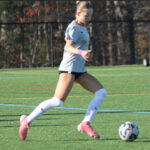Could Kyah Simon’s ACL tear have been prevented?
Editor’s note: This is the latest blog post from Dr. Wendy Lebolt, a longtime coach and physiologist who is the founder of Fit2Finish, a Northern Virginia-based training, fitness and rehabilitation company which works with teams and individual players to maximize health and performance. The Soccer Wire is excited to present Wendy’s learned perspectives on the mental, physical and psychological aspects of the beautiful game. Learn more about her background here.

Another one bites the dust. This time it’s Kyah Simon, 22-year-old Australian striker and Boston Breakers star, who tore her ACL just minutes after coming on for the Matildas in their friendly against the U.S. Women’s National Team on October 20.
This one deserves special attention because she had just entered the contest. Some will ask, was she warmed up to come in? I am one of the ones asking.
Why? Because properly designed and properly implemented injury prevention warm-ups significantly reduce the incidence of ACL tears in women athletes. This has been shown in large scale programs like Tim Hewett’s Sportsmetrics and the Santa Monica Sports Medicine Pep Program (PDF), along with other programs across the country.
Here is some of the supporting evidence:
“Young Athletes Most At Risk Of Knee Injuries Reap Big Benefit From Warm-Up Exercises”
“Program May Prevent Knee Injuries in Young Female Soccer Players”
For a really comprehensive review of what’s out there you can spend some time with the Hunt Valley 2006 report.
But the number of torn ACLs continues to rise, even in young, fit, highly-trained athletes. And by this I am referring to non-contact ACL tears. These are the ones where nobody knocks them, nobody tackles from behind, nobody “takes out their knee.”
We’re not talking gridiron football here. We’re talking futbol, the beautiful game.
Some of the difficulty results from coaches who are confused about “warm-up,” particularly ACL warm-up. By warm-up, we mean three things:
- increasing the body’s temperature
- moving the joints through their full range of motion
- activating the neuromuscular pathways responsible for coordinating movement
Temperature
Increasing temperature doesn’t necessarily mean running laps around the field. Anything that activates muscle contraction warms the body. Muscles give off heat. They turn up the temperature. It’s why we shiver when we’re cold. Those are tiny muscle contractions. It’s our body’s way of turning up the thermostat. It makes sense, then, that the larger the muscle or the bigger the movement, the greater the heat produced. But we want to do that gradually. And in cold weather, we need to do it more intentionally and with more care.
Increased temperature should always precede large-scale movement. Dynamic warm-up routines can satisfy this requirement if they begin with low-intensity movement to raise body temperature before moving to higher-intensity, more complex movement.
Full Range of Motion
Movement through full range of motion (ROM) should be part of any sport warm-up. Movement is what makes it “dynamic” and serves to lubricate (circulating fluid in joints) and protect the joint structures. Ideally, this is sport-specific. You warm up dynamically by moving at the joints that will be used.
For soccer, that means all the major joints, but especially the lower body. Start with smaller joints and small movements and build to larger joints with higher intensity. End with full body, dynamic challenges. Competitive athletes benefit from adding some controlled contact at the end.
What you’re doing is preparing them for exactly what they’ll face when they take the field.
Neuromuscular Activation
Neuromuscular activation is tuning in and tuning up the brain-nerve-muscle connection. And it’s where the bulk of the research is focused in trying to head off these injuries. The final part of warm-up should ask the athlete to perform game-like maneuvers at the pace and under the circumstances they will have to execute them on the field. Small-sided play or keep-away, which requires quick decisions, reflex maneuvers and change of direction will activate the neuromuscular pathways and prepare them for play.
Start a bit slow and build to game intensity before they enter the game.
This brings us to Kyah Simon, the substitute. Because if you have players perform warming, range of motion and quick play before the game, then you sit them on the bench, they cool down and tense up. A bit of shaking it out and a jog out to the corner flag does not bring them up to game speed. They need to re-enact a shortened version of the pre-game warm-up.
Otherwise, they may end up like Kyah and hundreds of athletes like her who will face surgery and at least a year away from the games they love.
If you coach, warm up your players before all practices and all games. That means: temperature, lubrication and timing, just like you do for your high-performance vehicle. You’ll help protect them from injury and you’ll improve their performance.
It’s worth your time and their effort.
If you’d like some sample warm-up specifics, here’s a dynamic warm-up from Fit2Finish.
SOCCERWIRE MARKETPLACE
- Start the Season Strong at Loudoun Premier Cup!
- 50th Annual Rael Vodicka Memorial Tournament
- Soccer Marketing Internships at The St. James FC
- Job Opening: The St. James FC Goalkeeper Academy Coach
- Full-Time Director of Goalkeeping for The St. James FC
- visitRaleigh.com Showcase Series 2025, hosted by NCFC Youth
- OFFICIAL MANCHESTER CITY SOCCER CAMPS
- Join Official Elite Summer Soccer Camps with Europe’s Top Pro Clubs!
- OFFICIAL BAYERN MUNICH SUMMER CAMPS U.S.
- OFFICIAL FC BARCELONA CAMPS U.S.











